Vulnerability and adaptation to climate change on the South Australian coast: a coastal community perspective
VerifiedAdded on 2023/01/18
|14
|4055
|23
AI Summary
This research focuses on the vulnerability and adaptation to climate change on the South Australian coast from a coastal community perspective. It explores the impacts of climate change on coastal populations and emphasizes the importance of implementing effective adaptation strategies. The study aims to assess the effectiveness of online tools in determining the vulnerability of city councils in South Australia and propose feasible adaptation strategies for highly vulnerable communities.
Contribute Materials
Your contribution can guide someone’s learning journey. Share your
documents today.
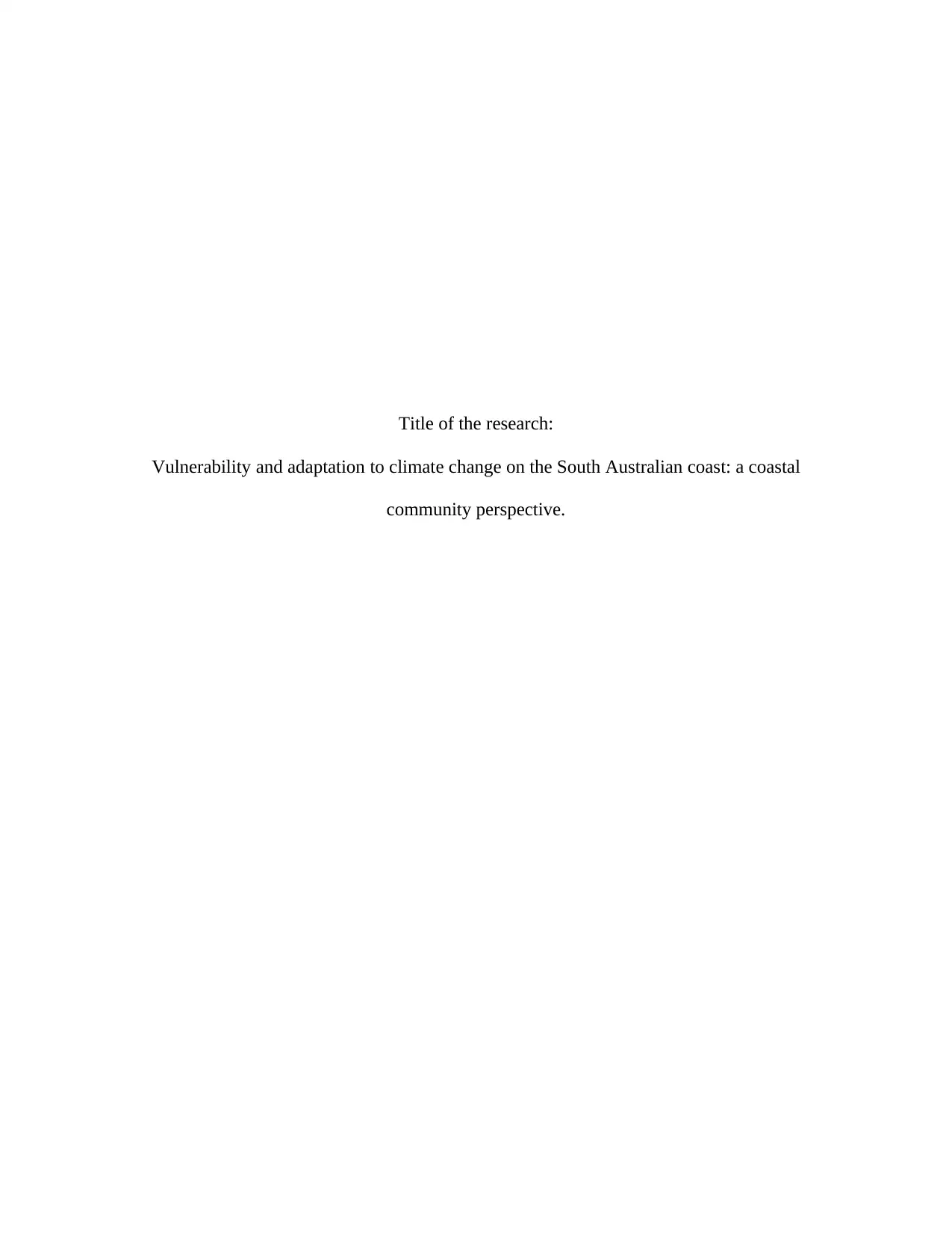
Title of the research:
Vulnerability and adaptation to climate change on the South Australian coast: a coastal
community perspective.
Vulnerability and adaptation to climate change on the South Australian coast: a coastal
community perspective.
Secure Best Marks with AI Grader
Need help grading? Try our AI Grader for instant feedback on your assignments.
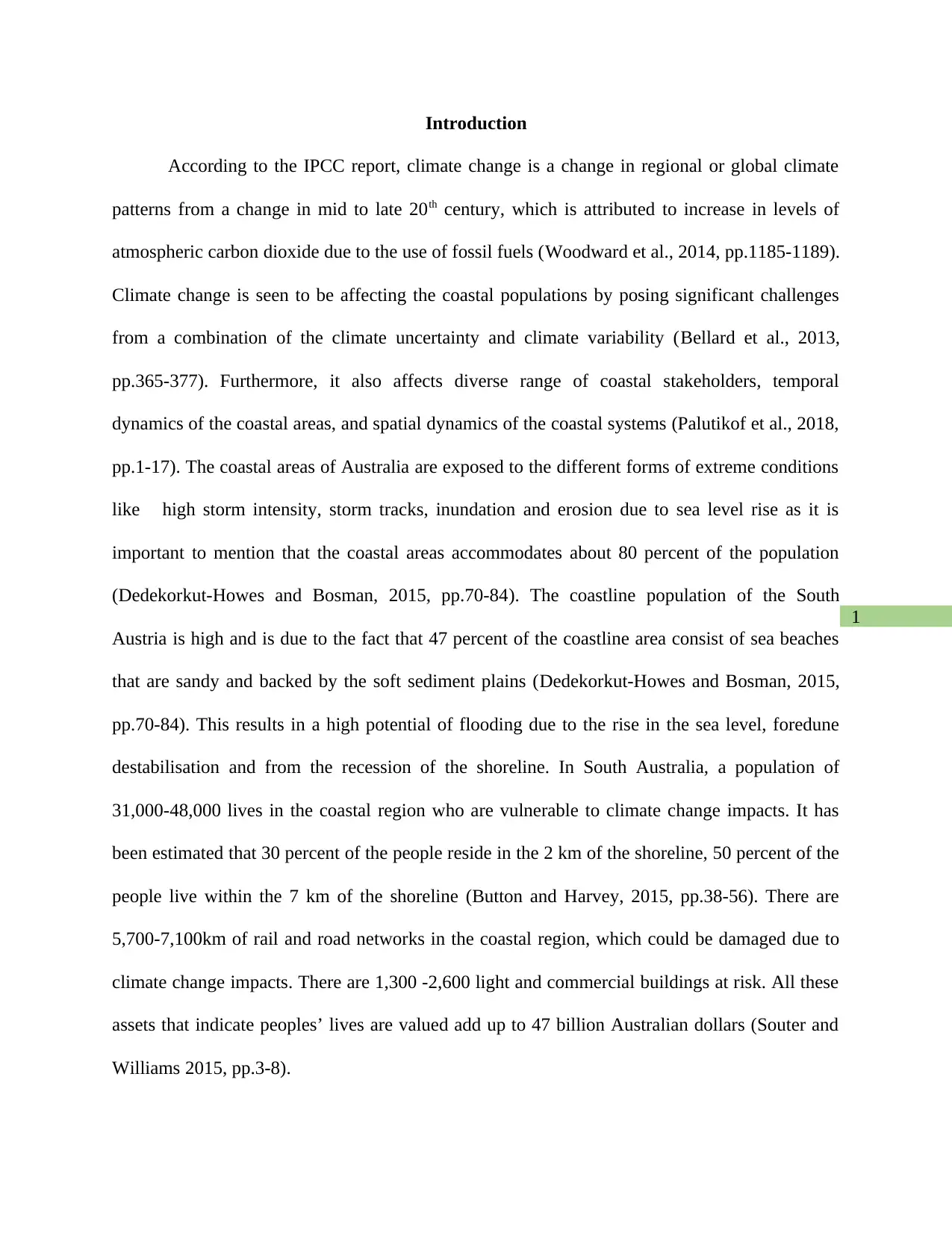
1
Introduction
According to the IPCC report, climate change is a change in regional or global climate
patterns from a change in mid to late 20th century, which is attributed to increase in levels of
atmospheric carbon dioxide due to the use of fossil fuels (Woodward et al., 2014, pp.1185-1189).
Climate change is seen to be affecting the coastal populations by posing significant challenges
from a combination of the climate uncertainty and climate variability (Bellard et al., 2013,
pp.365-377). Furthermore, it also affects diverse range of coastal stakeholders, temporal
dynamics of the coastal areas, and spatial dynamics of the coastal systems (Palutikof et al., 2018,
pp.1-17). The coastal areas of Australia are exposed to the different forms of extreme conditions
like high storm intensity, storm tracks, inundation and erosion due to sea level rise as it is
important to mention that the coastal areas accommodates about 80 percent of the population
(Dedekorkut-Howes and Bosman, 2015, pp.70-84). The coastline population of the South
Austria is high and is due to the fact that 47 percent of the coastline area consist of sea beaches
that are sandy and backed by the soft sediment plains (Dedekorkut-Howes and Bosman, 2015,
pp.70-84). This results in a high potential of flooding due to the rise in the sea level, foredune
destabilisation and from the recession of the shoreline. In South Australia, a population of
31,000-48,000 lives in the coastal region who are vulnerable to climate change impacts. It has
been estimated that 30 percent of the people reside in the 2 km of the shoreline, 50 percent of the
people live within the 7 km of the shoreline (Button and Harvey, 2015, pp.38-56). There are
5,700-7,100km of rail and road networks in the coastal region, which could be damaged due to
climate change impacts. There are 1,300 -2,600 light and commercial buildings at risk. All these
assets that indicate peoples’ lives are valued add up to 47 billion Australian dollars (Souter and
Williams 2015, pp.3-8).
Introduction
According to the IPCC report, climate change is a change in regional or global climate
patterns from a change in mid to late 20th century, which is attributed to increase in levels of
atmospheric carbon dioxide due to the use of fossil fuels (Woodward et al., 2014, pp.1185-1189).
Climate change is seen to be affecting the coastal populations by posing significant challenges
from a combination of the climate uncertainty and climate variability (Bellard et al., 2013,
pp.365-377). Furthermore, it also affects diverse range of coastal stakeholders, temporal
dynamics of the coastal areas, and spatial dynamics of the coastal systems (Palutikof et al., 2018,
pp.1-17). The coastal areas of Australia are exposed to the different forms of extreme conditions
like high storm intensity, storm tracks, inundation and erosion due to sea level rise as it is
important to mention that the coastal areas accommodates about 80 percent of the population
(Dedekorkut-Howes and Bosman, 2015, pp.70-84). The coastline population of the South
Austria is high and is due to the fact that 47 percent of the coastline area consist of sea beaches
that are sandy and backed by the soft sediment plains (Dedekorkut-Howes and Bosman, 2015,
pp.70-84). This results in a high potential of flooding due to the rise in the sea level, foredune
destabilisation and from the recession of the shoreline. In South Australia, a population of
31,000-48,000 lives in the coastal region who are vulnerable to climate change impacts. It has
been estimated that 30 percent of the people reside in the 2 km of the shoreline, 50 percent of the
people live within the 7 km of the shoreline (Button and Harvey, 2015, pp.38-56). There are
5,700-7,100km of rail and road networks in the coastal region, which could be damaged due to
climate change impacts. There are 1,300 -2,600 light and commercial buildings at risk. All these
assets that indicate peoples’ lives are valued add up to 47 billion Australian dollars (Souter and
Williams 2015, pp.3-8).
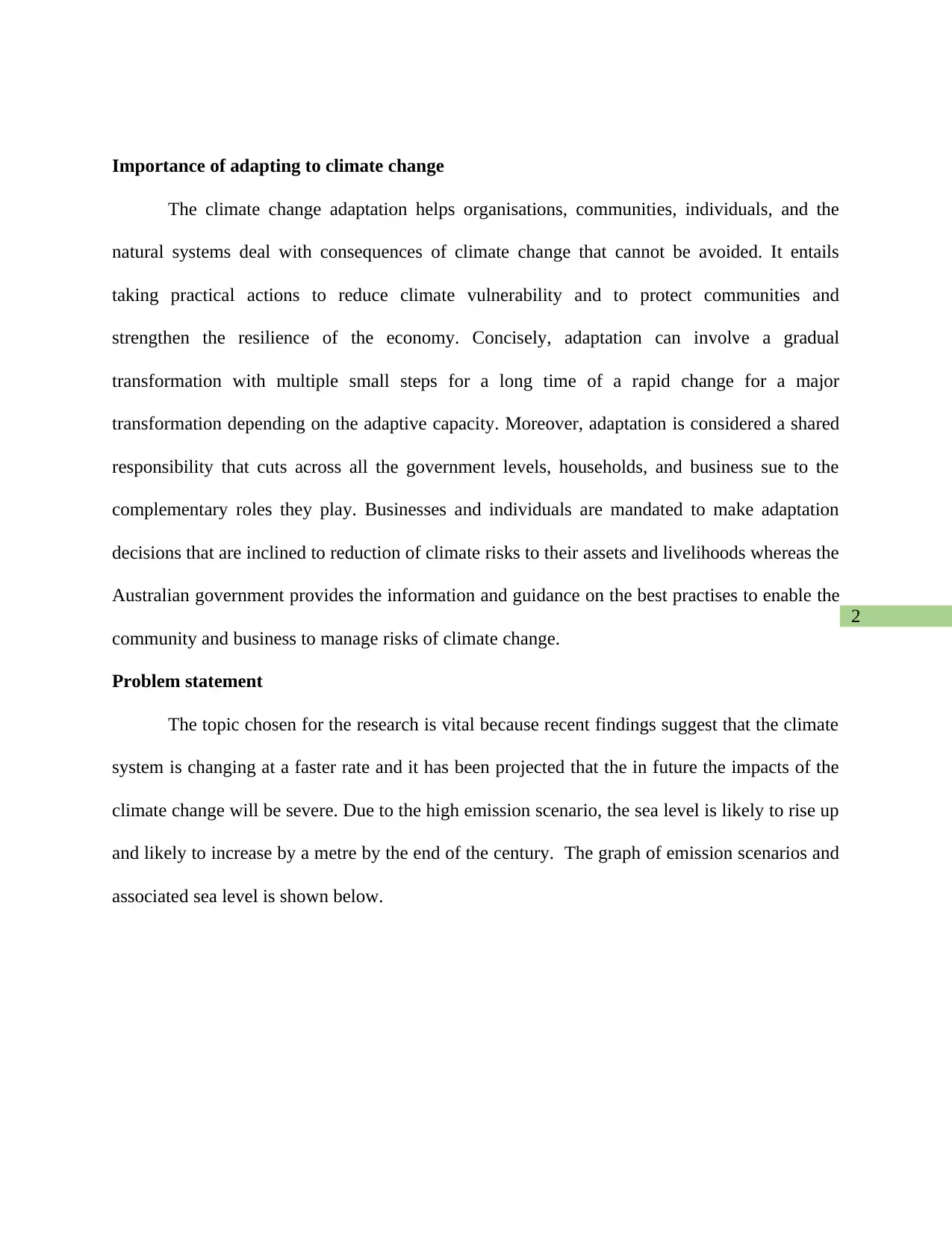
2
Importance of adapting to climate change
The climate change adaptation helps organisations, communities, individuals, and the
natural systems deal with consequences of climate change that cannot be avoided. It entails
taking practical actions to reduce climate vulnerability and to protect communities and
strengthen the resilience of the economy. Concisely, adaptation can involve a gradual
transformation with multiple small steps for a long time of a rapid change for a major
transformation depending on the adaptive capacity. Moreover, adaptation is considered a shared
responsibility that cuts across all the government levels, households, and business sue to the
complementary roles they play. Businesses and individuals are mandated to make adaptation
decisions that are inclined to reduction of climate risks to their assets and livelihoods whereas the
Australian government provides the information and guidance on the best practises to enable the
community and business to manage risks of climate change.
Problem statement
The topic chosen for the research is vital because recent findings suggest that the climate
system is changing at a faster rate and it has been projected that the in future the impacts of the
climate change will be severe. Due to the high emission scenario, the sea level is likely to rise up
and likely to increase by a metre by the end of the century. The graph of emission scenarios and
associated sea level is shown below.
Importance of adapting to climate change
The climate change adaptation helps organisations, communities, individuals, and the
natural systems deal with consequences of climate change that cannot be avoided. It entails
taking practical actions to reduce climate vulnerability and to protect communities and
strengthen the resilience of the economy. Concisely, adaptation can involve a gradual
transformation with multiple small steps for a long time of a rapid change for a major
transformation depending on the adaptive capacity. Moreover, adaptation is considered a shared
responsibility that cuts across all the government levels, households, and business sue to the
complementary roles they play. Businesses and individuals are mandated to make adaptation
decisions that are inclined to reduction of climate risks to their assets and livelihoods whereas the
Australian government provides the information and guidance on the best practises to enable the
community and business to manage risks of climate change.
Problem statement
The topic chosen for the research is vital because recent findings suggest that the climate
system is changing at a faster rate and it has been projected that the in future the impacts of the
climate change will be severe. Due to the high emission scenario, the sea level is likely to rise up
and likely to increase by a metre by the end of the century. The graph of emission scenarios and
associated sea level is shown below.
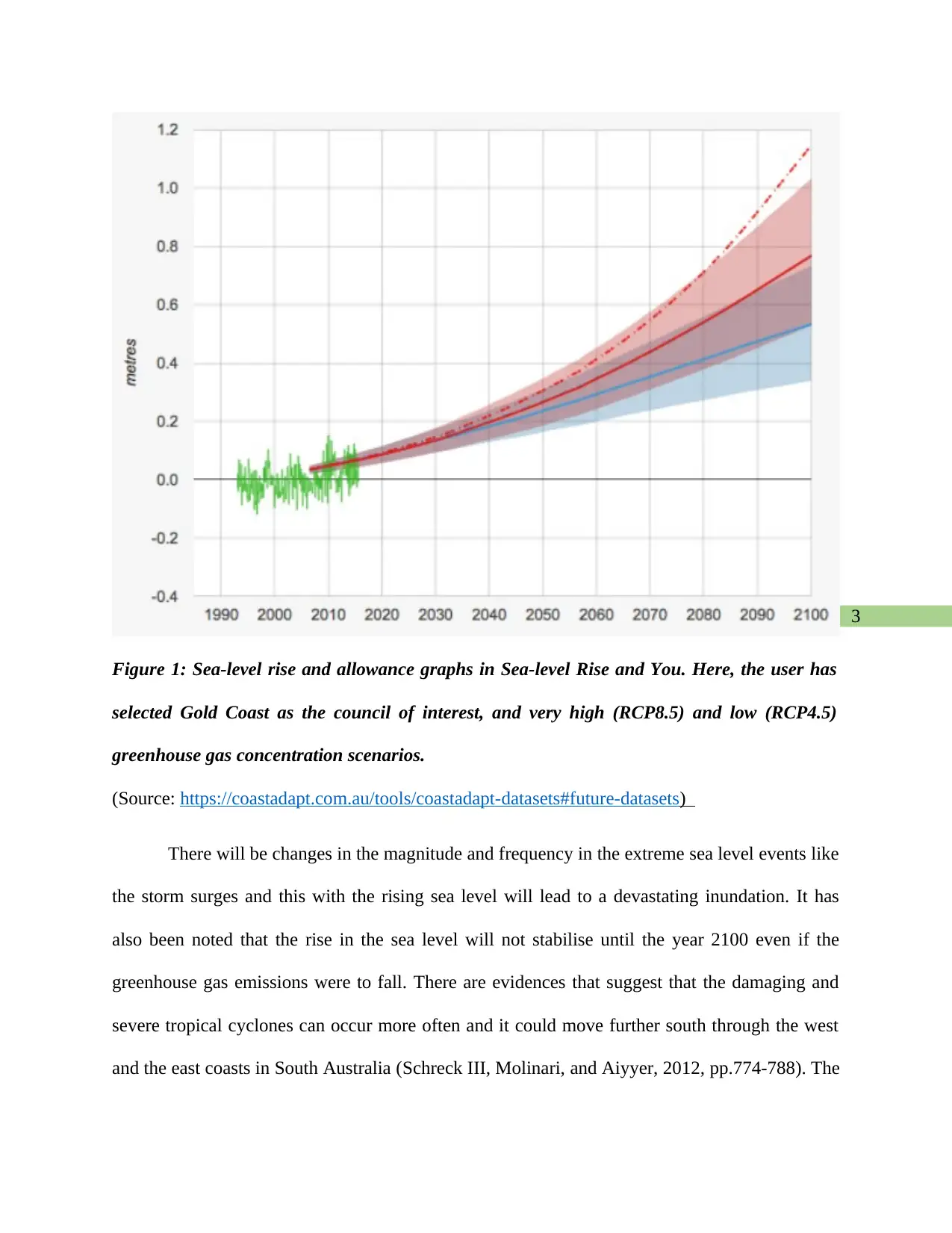
3
Figure 1: Sea-level rise and allowance graphs in Sea-level Rise and You. Here, the user has
selected Gold Coast as the council of interest, and very high (RCP8.5) and low (RCP4.5)
greenhouse gas concentration scenarios.
(Source: https://coastadapt.com.au/tools/coastadapt-datasets#future-datasets)
There will be changes in the magnitude and frequency in the extreme sea level events like
the storm surges and this with the rising sea level will lead to a devastating inundation. It has
also been noted that the rise in the sea level will not stabilise until the year 2100 even if the
greenhouse gas emissions were to fall. There are evidences that suggest that the damaging and
severe tropical cyclones can occur more often and it could move further south through the west
and the east coasts in South Australia (Schreck III, Molinari, and Aiyyer, 2012, pp.774-788). The
Figure 1: Sea-level rise and allowance graphs in Sea-level Rise and You. Here, the user has
selected Gold Coast as the council of interest, and very high (RCP8.5) and low (RCP4.5)
greenhouse gas concentration scenarios.
(Source: https://coastadapt.com.au/tools/coastadapt-datasets#future-datasets)
There will be changes in the magnitude and frequency in the extreme sea level events like
the storm surges and this with the rising sea level will lead to a devastating inundation. It has
also been noted that the rise in the sea level will not stabilise until the year 2100 even if the
greenhouse gas emissions were to fall. There are evidences that suggest that the damaging and
severe tropical cyclones can occur more often and it could move further south through the west
and the east coasts in South Australia (Schreck III, Molinari, and Aiyyer, 2012, pp.774-788). The
Secure Best Marks with AI Grader
Need help grading? Try our AI Grader for instant feedback on your assignments.

4
rising sea levels will cause increased rates of erosion and for several beaches that are around the
Australian coastline. The major uncertainties in the coastal risks are the change in the magnitude
of the sea level due to the melting of ice in the poles and erosion of the coasts (Government of
Australia, 2019). As much as an effort has been made at national level to develop online
tools to determine the vulnerability of communities, there is a gap in effort to downscale these to
local council level. Therefore, this research will attempt to assess the vulnerability of the coastal
communities that are residing in selected local councils in areas South Australia using online
tools available as well as attempt to explore whether appropriate action has been taken by the
local councils to reduce the vulnerability of communities. It will also attempt to propose
feasible adaptation strategies for the highly vulnerable communities, which could effectively
minimise the impact of climate change.
Rationale of the research
Climate change is the biggest challenge for all the coastal populations worldwide and the
situation has turned worse due to the combinations of diversity of the stakeholders, temporal and
spatial dynamics of the coastal systems, climate uncertainty and climate variability uncertainty
and climate variability (Deser, Phillips, Bourdette, and Teng, 2012, pp.527-546). The issues
associated with climate change are of major concern because of the rapid development of the
coastal areas and the population trends that showcase a massive growth in the coastal areas, and
it is expected to rise by the year 2025 (Dow and Downing, 2016). This is now an issue because
the coastal populations have been expected to grow and the increased amounts of attention is
required towards the operationalisation of the spaces and plans, development of the post policy
partnerships, and planning (Button and Harvey 2015). This research will explicitly focus on the
rising sea levels will cause increased rates of erosion and for several beaches that are around the
Australian coastline. The major uncertainties in the coastal risks are the change in the magnitude
of the sea level due to the melting of ice in the poles and erosion of the coasts (Government of
Australia, 2019). As much as an effort has been made at national level to develop online
tools to determine the vulnerability of communities, there is a gap in effort to downscale these to
local council level. Therefore, this research will attempt to assess the vulnerability of the coastal
communities that are residing in selected local councils in areas South Australia using online
tools available as well as attempt to explore whether appropriate action has been taken by the
local councils to reduce the vulnerability of communities. It will also attempt to propose
feasible adaptation strategies for the highly vulnerable communities, which could effectively
minimise the impact of climate change.
Rationale of the research
Climate change is the biggest challenge for all the coastal populations worldwide and the
situation has turned worse due to the combinations of diversity of the stakeholders, temporal and
spatial dynamics of the coastal systems, climate uncertainty and climate variability uncertainty
and climate variability (Deser, Phillips, Bourdette, and Teng, 2012, pp.527-546). The issues
associated with climate change are of major concern because of the rapid development of the
coastal areas and the population trends that showcase a massive growth in the coastal areas, and
it is expected to rise by the year 2025 (Dow and Downing, 2016). This is now an issue because
the coastal populations have been expected to grow and the increased amounts of attention is
required towards the operationalisation of the spaces and plans, development of the post policy
partnerships, and planning (Button and Harvey 2015). This research will explicitly focus on the
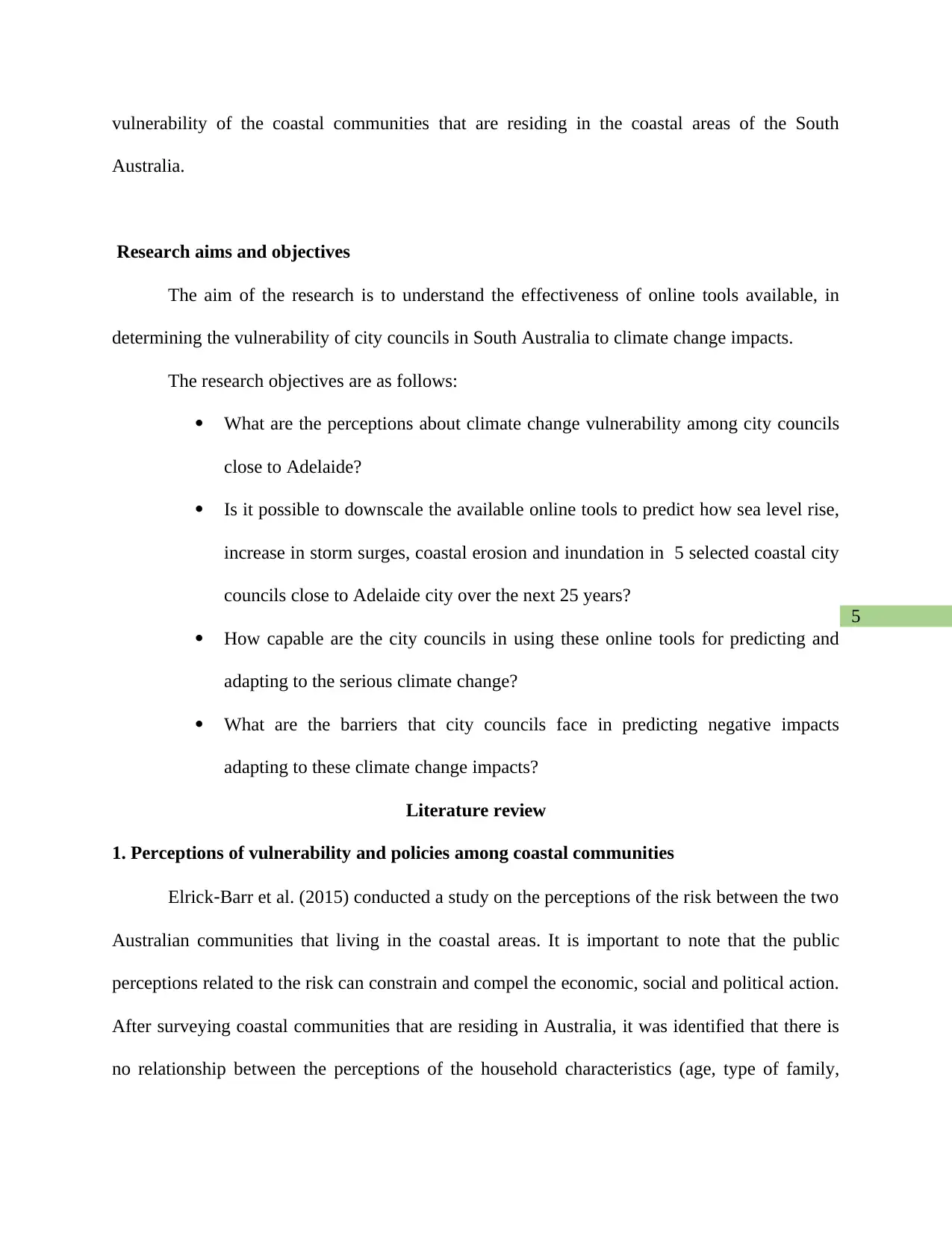
5
vulnerability of the coastal communities that are residing in the coastal areas of the South
Australia.
Research aims and objectives
The aim of the research is to understand the effectiveness of online tools available, in
determining the vulnerability of city councils in South Australia to climate change impacts.
The research objectives are as follows:
What are the perceptions about climate change vulnerability among city councils
close to Adelaide?
Is it possible to downscale the available online tools to predict how sea level rise,
increase in storm surges, coastal erosion and inundation in 5 selected coastal city
councils close to Adelaide city over the next 25 years?
How capable are the city councils in using these online tools for predicting and
adapting to the serious climate change?
What are the barriers that city councils face in predicting negative impacts
adapting to these climate change impacts?
Literature review
1. Perceptions of vulnerability and policies among coastal communities
Elrick‐Barr et al. (2015) conducted a study on the perceptions of the risk between the two
Australian communities that living in the coastal areas. It is important to note that the public
perceptions related to the risk can constrain and compel the economic, social and political action.
After surveying coastal communities that are residing in Australia, it was identified that there is
no relationship between the perceptions of the household characteristics (age, type of family,
vulnerability of the coastal communities that are residing in the coastal areas of the South
Australia.
Research aims and objectives
The aim of the research is to understand the effectiveness of online tools available, in
determining the vulnerability of city councils in South Australia to climate change impacts.
The research objectives are as follows:
What are the perceptions about climate change vulnerability among city councils
close to Adelaide?
Is it possible to downscale the available online tools to predict how sea level rise,
increase in storm surges, coastal erosion and inundation in 5 selected coastal city
councils close to Adelaide city over the next 25 years?
How capable are the city councils in using these online tools for predicting and
adapting to the serious climate change?
What are the barriers that city councils face in predicting negative impacts
adapting to these climate change impacts?
Literature review
1. Perceptions of vulnerability and policies among coastal communities
Elrick‐Barr et al. (2015) conducted a study on the perceptions of the risk between the two
Australian communities that living in the coastal areas. It is important to note that the public
perceptions related to the risk can constrain and compel the economic, social and political action.
After surveying coastal communities that are residing in Australia, it was identified that there is
no relationship between the perceptions of the household characteristics (age, type of family,
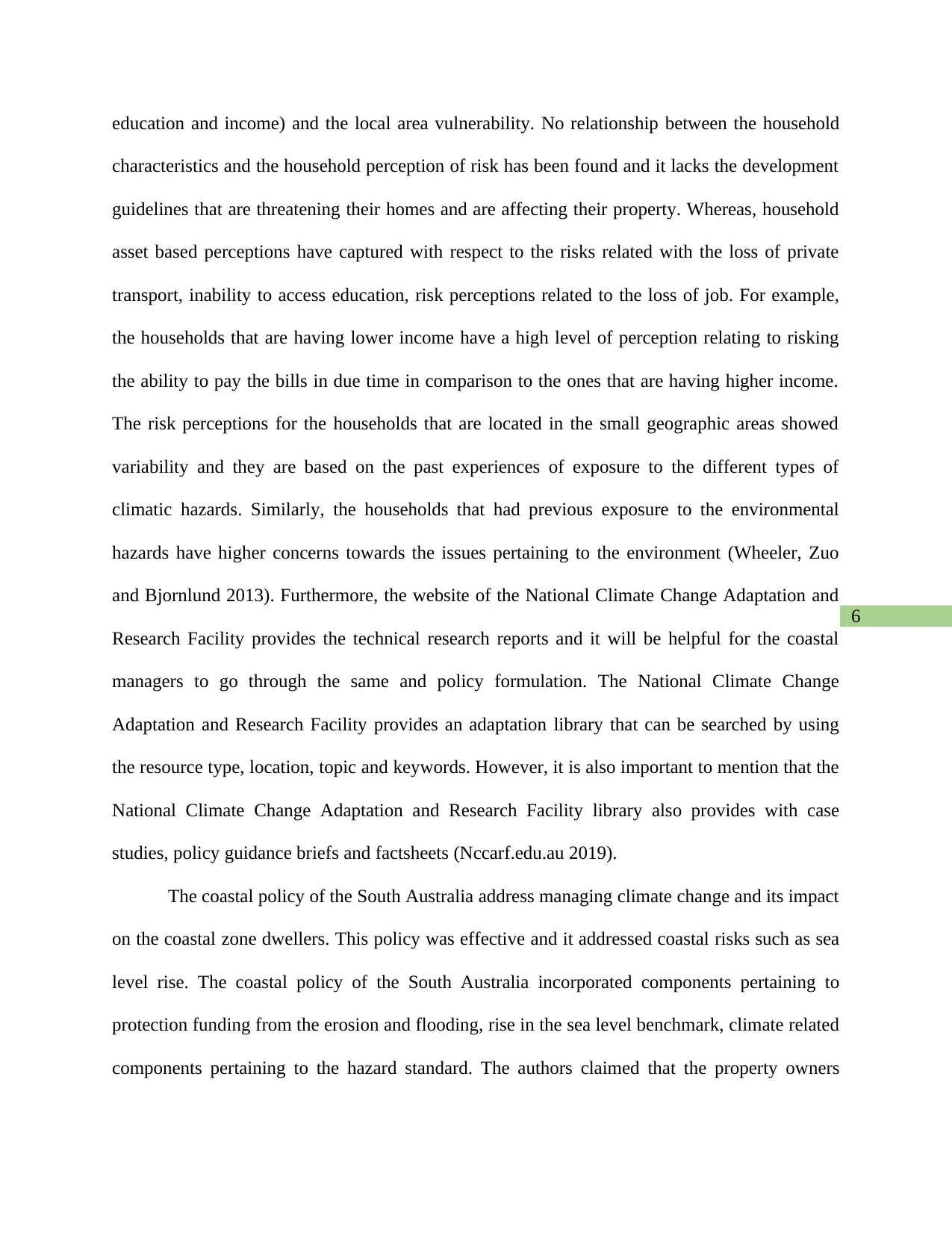
6
education and income) and the local area vulnerability. No relationship between the household
characteristics and the household perception of risk has been found and it lacks the development
guidelines that are threatening their homes and are affecting their property. Whereas, household
asset based perceptions have captured with respect to the risks related with the loss of private
transport, inability to access education, risk perceptions related to the loss of job. For example,
the households that are having lower income have a high level of perception relating to risking
the ability to pay the bills in due time in comparison to the ones that are having higher income.
The risk perceptions for the households that are located in the small geographic areas showed
variability and they are based on the past experiences of exposure to the different types of
climatic hazards. Similarly, the households that had previous exposure to the environmental
hazards have higher concerns towards the issues pertaining to the environment (Wheeler, Zuo
and Bjornlund 2013). Furthermore, the website of the National Climate Change Adaptation and
Research Facility provides the technical research reports and it will be helpful for the coastal
managers to go through the same and policy formulation. The National Climate Change
Adaptation and Research Facility provides an adaptation library that can be searched by using
the resource type, location, topic and keywords. However, it is also important to mention that the
National Climate Change Adaptation and Research Facility library also provides with case
studies, policy guidance briefs and factsheets (Nccarf.edu.au 2019).
The coastal policy of the South Australia address managing climate change and its impact
on the coastal zone dwellers. This policy was effective and it addressed coastal risks such as sea
level rise. The coastal policy of the South Australia incorporated components pertaining to
protection funding from the erosion and flooding, rise in the sea level benchmark, climate related
components pertaining to the hazard standard. The authors claimed that the property owners
education and income) and the local area vulnerability. No relationship between the household
characteristics and the household perception of risk has been found and it lacks the development
guidelines that are threatening their homes and are affecting their property. Whereas, household
asset based perceptions have captured with respect to the risks related with the loss of private
transport, inability to access education, risk perceptions related to the loss of job. For example,
the households that are having lower income have a high level of perception relating to risking
the ability to pay the bills in due time in comparison to the ones that are having higher income.
The risk perceptions for the households that are located in the small geographic areas showed
variability and they are based on the past experiences of exposure to the different types of
climatic hazards. Similarly, the households that had previous exposure to the environmental
hazards have higher concerns towards the issues pertaining to the environment (Wheeler, Zuo
and Bjornlund 2013). Furthermore, the website of the National Climate Change Adaptation and
Research Facility provides the technical research reports and it will be helpful for the coastal
managers to go through the same and policy formulation. The National Climate Change
Adaptation and Research Facility provides an adaptation library that can be searched by using
the resource type, location, topic and keywords. However, it is also important to mention that the
National Climate Change Adaptation and Research Facility library also provides with case
studies, policy guidance briefs and factsheets (Nccarf.edu.au 2019).
The coastal policy of the South Australia address managing climate change and its impact
on the coastal zone dwellers. This policy was effective and it addressed coastal risks such as sea
level rise. The coastal policy of the South Australia incorporated components pertaining to
protection funding from the erosion and flooding, rise in the sea level benchmark, climate related
components pertaining to the hazard standard. The authors claimed that the property owners
Paraphrase This Document
Need a fresh take? Get an instant paraphrase of this document with our AI Paraphraser
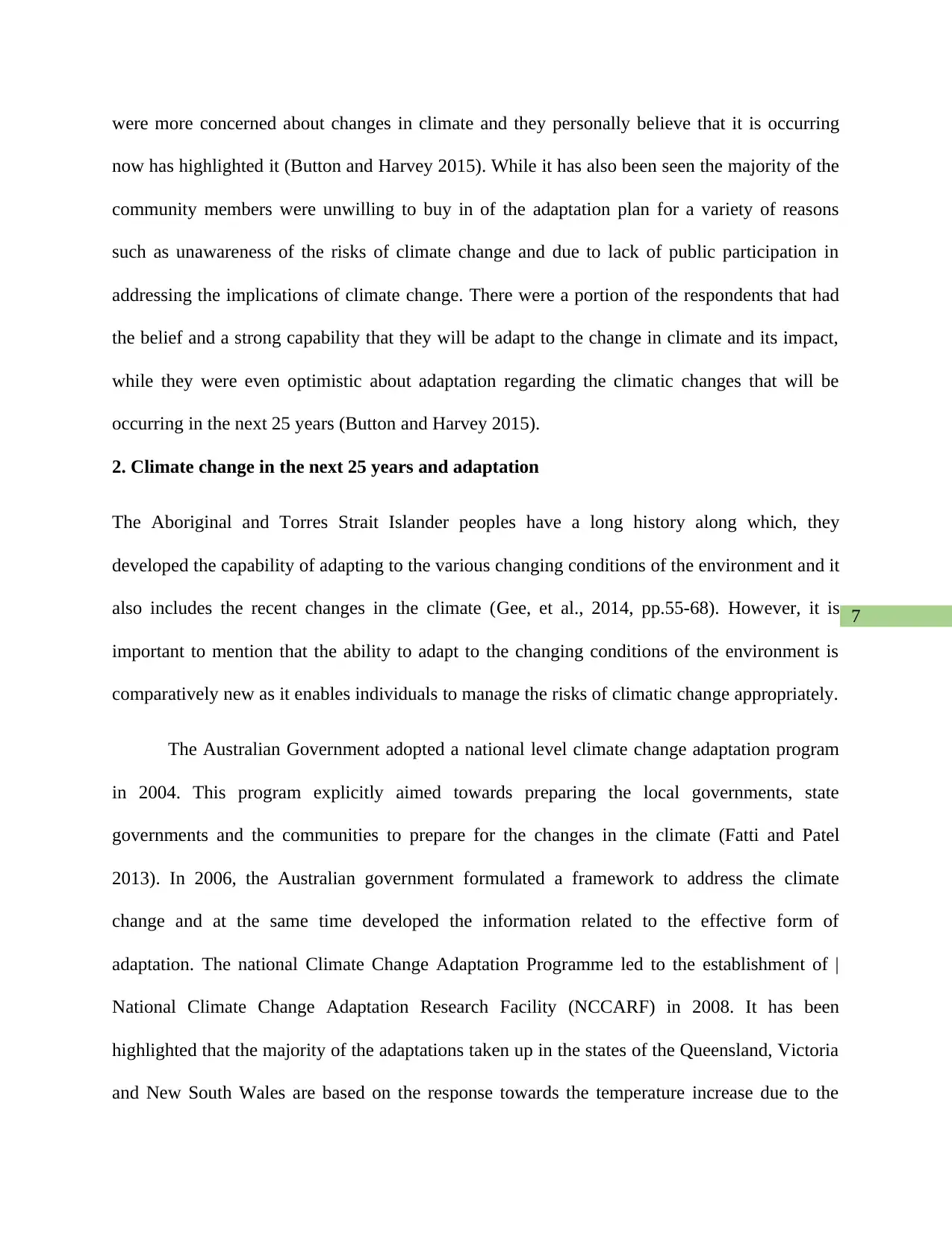
7
were more concerned about changes in climate and they personally believe that it is occurring
now has highlighted it (Button and Harvey 2015). While it has also been seen the majority of the
community members were unwilling to buy in of the adaptation plan for a variety of reasons
such as unawareness of the risks of climate change and due to lack of public participation in
addressing the implications of climate change. There were a portion of the respondents that had
the belief and a strong capability that they will be adapt to the change in climate and its impact,
while they were even optimistic about adaptation regarding the climatic changes that will be
occurring in the next 25 years (Button and Harvey 2015).
2. Climate change in the next 25 years and adaptation
The Aboriginal and Torres Strait Islander peoples have a long history along which, they
developed the capability of adapting to the various changing conditions of the environment and it
also includes the recent changes in the climate (Gee, et al., 2014, pp.55-68). However, it is
important to mention that the ability to adapt to the changing conditions of the environment is
comparatively new as it enables individuals to manage the risks of climatic change appropriately.
The Australian Government adopted a national level climate change adaptation program
in 2004. This program explicitly aimed towards preparing the local governments, state
governments and the communities to prepare for the changes in the climate (Fatti and Patel
2013). In 2006, the Australian government formulated a framework to address the climate
change and at the same time developed the information related to the effective form of
adaptation. The national Climate Change Adaptation Programme led to the establishment of |
National Climate Change Adaptation Research Facility (NCCARF) in 2008. It has been
highlighted that the majority of the adaptations taken up in the states of the Queensland, Victoria
and New South Wales are based on the response towards the temperature increase due to the
were more concerned about changes in climate and they personally believe that it is occurring
now has highlighted it (Button and Harvey 2015). While it has also been seen the majority of the
community members were unwilling to buy in of the adaptation plan for a variety of reasons
such as unawareness of the risks of climate change and due to lack of public participation in
addressing the implications of climate change. There were a portion of the respondents that had
the belief and a strong capability that they will be adapt to the change in climate and its impact,
while they were even optimistic about adaptation regarding the climatic changes that will be
occurring in the next 25 years (Button and Harvey 2015).
2. Climate change in the next 25 years and adaptation
The Aboriginal and Torres Strait Islander peoples have a long history along which, they
developed the capability of adapting to the various changing conditions of the environment and it
also includes the recent changes in the climate (Gee, et al., 2014, pp.55-68). However, it is
important to mention that the ability to adapt to the changing conditions of the environment is
comparatively new as it enables individuals to manage the risks of climatic change appropriately.
The Australian Government adopted a national level climate change adaptation program
in 2004. This program explicitly aimed towards preparing the local governments, state
governments and the communities to prepare for the changes in the climate (Fatti and Patel
2013). In 2006, the Australian government formulated a framework to address the climate
change and at the same time developed the information related to the effective form of
adaptation. The national Climate Change Adaptation Programme led to the establishment of |
National Climate Change Adaptation Research Facility (NCCARF) in 2008. It has been
highlighted that the majority of the adaptations taken up in the states of the Queensland, Victoria
and New South Wales are based on the response towards the temperature increase due to the

8
climate change and the rise in sea level (Head et al., pp.175-197.). Furthermore, steps were taken
to severe weather events like the cyclones that are occurring at an increased frequency and
increased intensity (Head et al., pp.175-197). The rise in sea level is especially emphasised in
these regions and the reason is the presence of capital infrastructure, risk of loss of the habitable
lands, damage and inundation to the assets (Head et al., pp.175-197).
3. Climate change and coastal areas
It has been highlighted by Lipiec et al. (2018) that the coastal communities are always at
the risk from the various types of the coastal hazards such as local decision makers lack proper
tools that are required for the reduction of the change in climate. The state governments and the
local governments are unable to manage the changing and dynamic environment that is slow and
are unable to comply with the governance structure due to unawareness and ignorance of risks of
climate change among the people. The coastal decision makers have limitations on implementing
a particular policy and the potential benefits within environmental policies. . Ramm et al. (2017)
has mentioned that Australia is an arid country and about 85 percent of the population resides
near water sources in the coast. It has been shown that in the last 100 hundred years there has
been a rise in the rate of the sea level and it has even accelerated in the recent times (Jacob,
Wahr, Pfeffer, and Swenson, 2012, p.514in Australia and in the region, the sea level has
increased comparable to the global rates (Jacob et al., 2012, p.514) . The rise in the sea level has
led to the increase in a number of natural hazards like coastal erosion and storm surges give the
source of this information or name some events/statistics. There is a gap in literature about tools
that can be used by local councils and communities in cities about impacts of climate change and
this research attempts to address this gap.
Methodology
climate change and the rise in sea level (Head et al., pp.175-197.). Furthermore, steps were taken
to severe weather events like the cyclones that are occurring at an increased frequency and
increased intensity (Head et al., pp.175-197). The rise in sea level is especially emphasised in
these regions and the reason is the presence of capital infrastructure, risk of loss of the habitable
lands, damage and inundation to the assets (Head et al., pp.175-197).
3. Climate change and coastal areas
It has been highlighted by Lipiec et al. (2018) that the coastal communities are always at
the risk from the various types of the coastal hazards such as local decision makers lack proper
tools that are required for the reduction of the change in climate. The state governments and the
local governments are unable to manage the changing and dynamic environment that is slow and
are unable to comply with the governance structure due to unawareness and ignorance of risks of
climate change among the people. The coastal decision makers have limitations on implementing
a particular policy and the potential benefits within environmental policies. . Ramm et al. (2017)
has mentioned that Australia is an arid country and about 85 percent of the population resides
near water sources in the coast. It has been shown that in the last 100 hundred years there has
been a rise in the rate of the sea level and it has even accelerated in the recent times (Jacob,
Wahr, Pfeffer, and Swenson, 2012, p.514in Australia and in the region, the sea level has
increased comparable to the global rates (Jacob et al., 2012, p.514) . The rise in the sea level has
led to the increase in a number of natural hazards like coastal erosion and storm surges give the
source of this information or name some events/statistics. There is a gap in literature about tools
that can be used by local councils and communities in cities about impacts of climate change and
this research attempts to address this gap.
Methodology

9
The research will follow a qualitative methodology in examining the effectiveness of
various tools available online to determine the vulnerability of selected city councils to prioritise
climate change impacts. The priority climate change impacts selected for this research are: sea
level rise, coastal storm surges, inundation, and coastal erosion. A set of criteria will be
developed to determine the vulnerability of a local city council to climate change impacts,
against which five city councils will be evaluated.
Five city councils within South Australia will be selected based on their ease to access
from Adelaide during the short time available for this research. Online tools such as the
CoastAdapt website that provides a comprehensive guidance and information for coastal
managers seeking to adapt is one of the key tools that would be used to evaluate the vulnerability
of city councils during this research (Coastadapt.com.au 2019). The CoastAdapt will access the
data sets at the local scale and product visualisation will also be present to understand the climate
related risks (Nccarf 2019). The C-CADS will provide a unifying framework for unifying the
CoastAdapt and its checklists, case studies and he datasets. CoastAdapt will include the risk
assessment framework with three different stages of risk assessment, checklists and templates
(Coastadapt., 2019).
In-depth semi-structured Interviews will be conducted with managers of the 5 coastal city
councils, which are close to Adelaide city. The data will be collected based on the how the
community members are seeking to understand the i) information pertaining to adaptation and its
data sets; ii) process of the management of risk and management of adaptation in the coastal
areas; iii) a mechanism through which the users can interact. The online tools such as the Coast
adapt data sets which explores the real-time or present day and future information will be
The research will follow a qualitative methodology in examining the effectiveness of
various tools available online to determine the vulnerability of selected city councils to prioritise
climate change impacts. The priority climate change impacts selected for this research are: sea
level rise, coastal storm surges, inundation, and coastal erosion. A set of criteria will be
developed to determine the vulnerability of a local city council to climate change impacts,
against which five city councils will be evaluated.
Five city councils within South Australia will be selected based on their ease to access
from Adelaide during the short time available for this research. Online tools such as the
CoastAdapt website that provides a comprehensive guidance and information for coastal
managers seeking to adapt is one of the key tools that would be used to evaluate the vulnerability
of city councils during this research (Coastadapt.com.au 2019). The CoastAdapt will access the
data sets at the local scale and product visualisation will also be present to understand the climate
related risks (Nccarf 2019). The C-CADS will provide a unifying framework for unifying the
CoastAdapt and its checklists, case studies and he datasets. CoastAdapt will include the risk
assessment framework with three different stages of risk assessment, checklists and templates
(Coastadapt., 2019).
In-depth semi-structured Interviews will be conducted with managers of the 5 coastal city
councils, which are close to Adelaide city. The data will be collected based on the how the
community members are seeking to understand the i) information pertaining to adaptation and its
data sets; ii) process of the management of risk and management of adaptation in the coastal
areas; iii) a mechanism through which the users can interact. The online tools such as the Coast
adapt data sets which explores the real-time or present day and future information will be
Secure Best Marks with AI Grader
Need help grading? Try our AI Grader for instant feedback on your assignments.
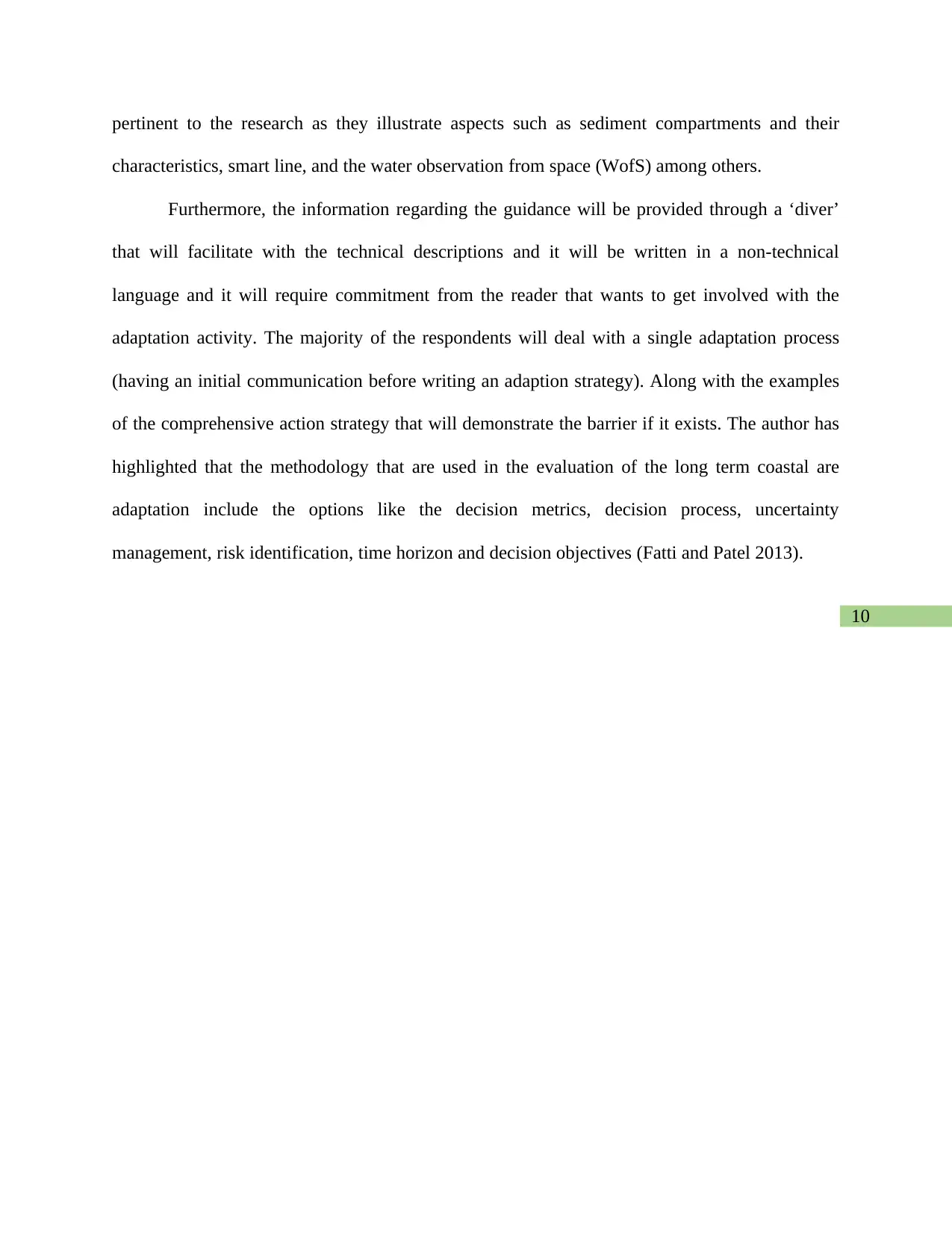
10
pertinent to the research as they illustrate aspects such as sediment compartments and their
characteristics, smart line, and the water observation from space (WofS) among others.
Furthermore, the information regarding the guidance will be provided through a ‘diver’
that will facilitate with the technical descriptions and it will be written in a non-technical
language and it will require commitment from the reader that wants to get involved with the
adaptation activity. The majority of the respondents will deal with a single adaptation process
(having an initial communication before writing an adaption strategy). Along with the examples
of the comprehensive action strategy that will demonstrate the barrier if it exists. The author has
highlighted that the methodology that are used in the evaluation of the long term coastal are
adaptation include the options like the decision metrics, decision process, uncertainty
management, risk identification, time horizon and decision objectives (Fatti and Patel 2013).
pertinent to the research as they illustrate aspects such as sediment compartments and their
characteristics, smart line, and the water observation from space (WofS) among others.
Furthermore, the information regarding the guidance will be provided through a ‘diver’
that will facilitate with the technical descriptions and it will be written in a non-technical
language and it will require commitment from the reader that wants to get involved with the
adaptation activity. The majority of the respondents will deal with a single adaptation process
(having an initial communication before writing an adaption strategy). Along with the examples
of the comprehensive action strategy that will demonstrate the barrier if it exists. The author has
highlighted that the methodology that are used in the evaluation of the long term coastal are
adaptation include the options like the decision metrics, decision process, uncertainty
management, risk identification, time horizon and decision objectives (Fatti and Patel 2013).
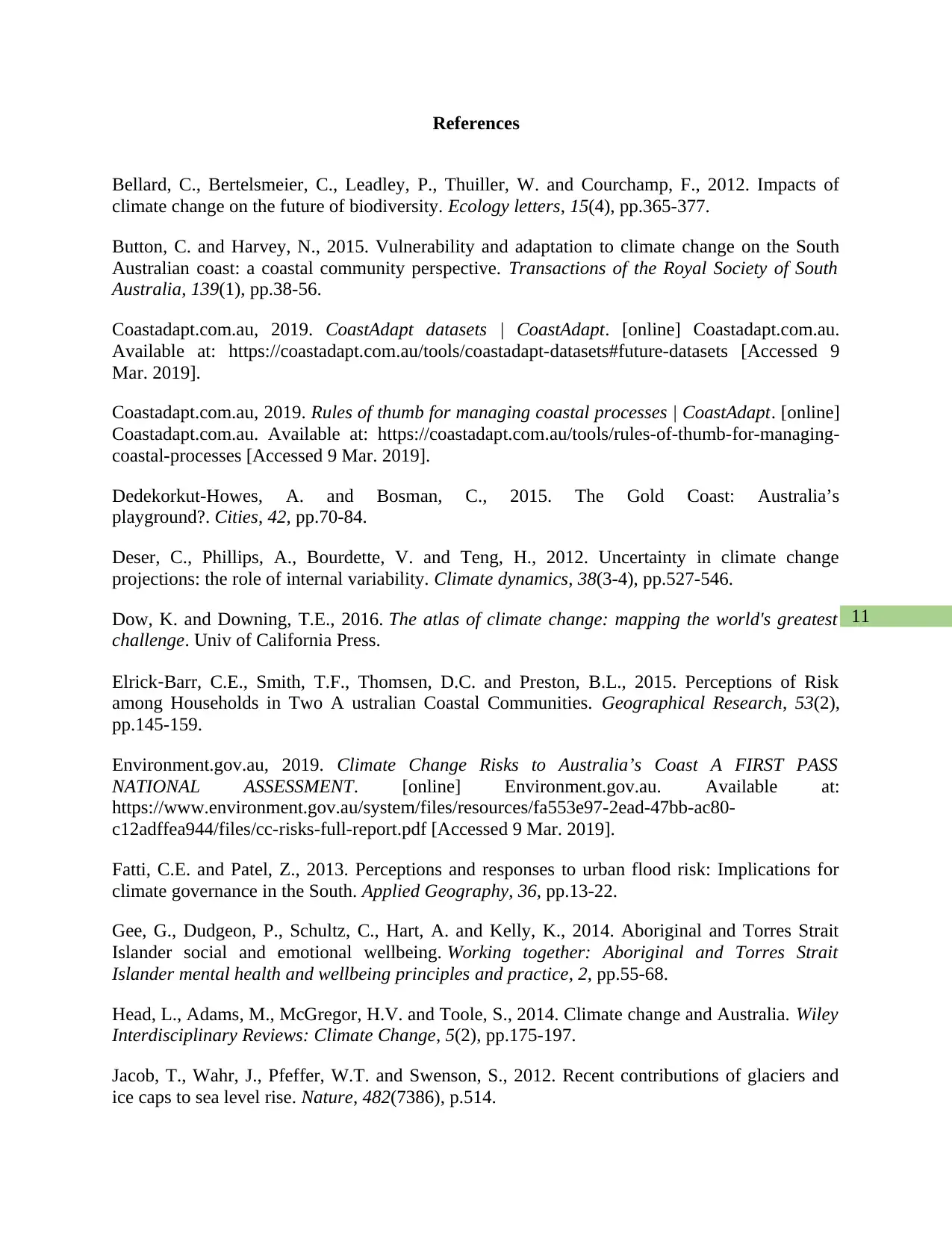
11
References
Bellard, C., Bertelsmeier, C., Leadley, P., Thuiller, W. and Courchamp, F., 2012. Impacts of
climate change on the future of biodiversity. Ecology letters, 15(4), pp.365-377.
Button, C. and Harvey, N., 2015. Vulnerability and adaptation to climate change on the South
Australian coast: a coastal community perspective. Transactions of the Royal Society of South
Australia, 139(1), pp.38-56.
Coastadapt.com.au, 2019. CoastAdapt datasets | CoastAdapt. [online] Coastadapt.com.au.
Available at: https://coastadapt.com.au/tools/coastadapt-datasets#future-datasets [Accessed 9
Mar. 2019].
Coastadapt.com.au, 2019. Rules of thumb for managing coastal processes | CoastAdapt. [online]
Coastadapt.com.au. Available at: https://coastadapt.com.au/tools/rules-of-thumb-for-managing-
coastal-processes [Accessed 9 Mar. 2019].
Dedekorkut-Howes, A. and Bosman, C., 2015. The Gold Coast: Australia’s
playground?. Cities, 42, pp.70-84.
Deser, C., Phillips, A., Bourdette, V. and Teng, H., 2012. Uncertainty in climate change
projections: the role of internal variability. Climate dynamics, 38(3-4), pp.527-546.
Dow, K. and Downing, T.E., 2016. The atlas of climate change: mapping the world's greatest
challenge. Univ of California Press.
Elrick‐Barr, C.E., Smith, T.F., Thomsen, D.C. and Preston, B.L., 2015. Perceptions of Risk
among Households in Two A ustralian Coastal Communities. Geographical Research, 53(2),
pp.145-159.
Environment.gov.au, 2019. Climate Change Risks to Australia’s Coast A FIRST PASS
NATIONAL ASSESSMENT. [online] Environment.gov.au. Available at:
https://www.environment.gov.au/system/files/resources/fa553e97-2ead-47bb-ac80-
c12adffea944/files/cc-risks-full-report.pdf [Accessed 9 Mar. 2019].
Fatti, C.E. and Patel, Z., 2013. Perceptions and responses to urban flood risk: Implications for
climate governance in the South. Applied Geography, 36, pp.13-22.
Gee, G., Dudgeon, P., Schultz, C., Hart, A. and Kelly, K., 2014. Aboriginal and Torres Strait
Islander social and emotional wellbeing. Working together: Aboriginal and Torres Strait
Islander mental health and wellbeing principles and practice, 2, pp.55-68.
Head, L., Adams, M., McGregor, H.V. and Toole, S., 2014. Climate change and Australia. Wiley
Interdisciplinary Reviews: Climate Change, 5(2), pp.175-197.
Jacob, T., Wahr, J., Pfeffer, W.T. and Swenson, S., 2012. Recent contributions of glaciers and
ice caps to sea level rise. Nature, 482(7386), p.514.
References
Bellard, C., Bertelsmeier, C., Leadley, P., Thuiller, W. and Courchamp, F., 2012. Impacts of
climate change on the future of biodiversity. Ecology letters, 15(4), pp.365-377.
Button, C. and Harvey, N., 2015. Vulnerability and adaptation to climate change on the South
Australian coast: a coastal community perspective. Transactions of the Royal Society of South
Australia, 139(1), pp.38-56.
Coastadapt.com.au, 2019. CoastAdapt datasets | CoastAdapt. [online] Coastadapt.com.au.
Available at: https://coastadapt.com.au/tools/coastadapt-datasets#future-datasets [Accessed 9
Mar. 2019].
Coastadapt.com.au, 2019. Rules of thumb for managing coastal processes | CoastAdapt. [online]
Coastadapt.com.au. Available at: https://coastadapt.com.au/tools/rules-of-thumb-for-managing-
coastal-processes [Accessed 9 Mar. 2019].
Dedekorkut-Howes, A. and Bosman, C., 2015. The Gold Coast: Australia’s
playground?. Cities, 42, pp.70-84.
Deser, C., Phillips, A., Bourdette, V. and Teng, H., 2012. Uncertainty in climate change
projections: the role of internal variability. Climate dynamics, 38(3-4), pp.527-546.
Dow, K. and Downing, T.E., 2016. The atlas of climate change: mapping the world's greatest
challenge. Univ of California Press.
Elrick‐Barr, C.E., Smith, T.F., Thomsen, D.C. and Preston, B.L., 2015. Perceptions of Risk
among Households in Two A ustralian Coastal Communities. Geographical Research, 53(2),
pp.145-159.
Environment.gov.au, 2019. Climate Change Risks to Australia’s Coast A FIRST PASS
NATIONAL ASSESSMENT. [online] Environment.gov.au. Available at:
https://www.environment.gov.au/system/files/resources/fa553e97-2ead-47bb-ac80-
c12adffea944/files/cc-risks-full-report.pdf [Accessed 9 Mar. 2019].
Fatti, C.E. and Patel, Z., 2013. Perceptions and responses to urban flood risk: Implications for
climate governance in the South. Applied Geography, 36, pp.13-22.
Gee, G., Dudgeon, P., Schultz, C., Hart, A. and Kelly, K., 2014. Aboriginal and Torres Strait
Islander social and emotional wellbeing. Working together: Aboriginal and Torres Strait
Islander mental health and wellbeing principles and practice, 2, pp.55-68.
Head, L., Adams, M., McGregor, H.V. and Toole, S., 2014. Climate change and Australia. Wiley
Interdisciplinary Reviews: Climate Change, 5(2), pp.175-197.
Jacob, T., Wahr, J., Pfeffer, W.T. and Swenson, S., 2012. Recent contributions of glaciers and
ice caps to sea level rise. Nature, 482(7386), p.514.

12
Lipiec, E., Ruggiero, P., Mills, A., Serafin, K.A., Bolte, J., Corcoran, P., Stevenson, J., Zanocco,
C. and Lach, D., 2018. Mapping out climate change: Assessing how coastal communities adapt
using alternative future scenarios. Journal of Coastal Research, 34(5), pp.1196-1208.
Nccarf.edu.au, 2019. NCCARF - National Climate Change Adaptation Research Facility.
[online] Nccarf.edu.au. Available at: https://www.nccarf.edu.au/content/coastal-tool-overview
[Accessed 9 Mar. 2019].
Nccarf.edu.au, 2019. NCCARF - National Climate Change Adaptation Research Facility.
[online] Nccarf.edu.au. Available at: https://www.nccarf.edu.au/biblio [Accessed 9 Mar. 2019].
Palutikof, J.P., Rissik, D., Webb, S., Tonmoy, F.N., Boulter, S.L., Leitch, A.M., Perez Vidaurre,
A.C. and Campbell, M.J., 2018. CoastAdapt: an adaptation decision support framework for
Australia’s coastal managers. Climatic Change, pp.1-17.
Pearce, T., Rodríguez, E., Fawcett, D. and Ford, J., 2018. How Is Australia Adapting to Climate
Change Based on a Systematic Review?. Sustainability, 10(9), p.3280.
Ramm, T.D., White, C.J., Chan, A.H.C. and Watson, C.S., 2017. A review of methodologies
applied in Australian practice to evaluate long-term coastal adaptation options. Climate Risk
Management, 17, pp.35-51.
Schreck III, C.J., Molinari, J. and Aiyyer, A., 2012. A global view of equatorial waves and
tropical cyclogenesis. Monthly Weather Review, 140(3), pp.774-788.
Souter, N.J. and Williams, C.R., 2015. The climate change SA symposium 2013: a synthesis.
Transactions of the Royal Society of South Australia, 139(1), pp.3-8.
Wheeler, S., Zuo, A. and Bjornlund, H., 2013. Farmers’ climate change beliefs and adaptation
strategies for a water scarce future in Australia. Global Environmental Change, 23(2), pp.537-
547.
Woodward, A., Smith, K.R., Campbell-Lendrum, D., Chadee, D.D., Honda, Y., Liu, Q., Olwoch,
J., Revich, B., Sauerborn, R., Chafe, Z. and Confalonieri, U., 2014. Climate change and health:
on the latest IPCC report. The Lancet, 383(9924), pp.1185-1189.
Lipiec, E., Ruggiero, P., Mills, A., Serafin, K.A., Bolte, J., Corcoran, P., Stevenson, J., Zanocco,
C. and Lach, D., 2018. Mapping out climate change: Assessing how coastal communities adapt
using alternative future scenarios. Journal of Coastal Research, 34(5), pp.1196-1208.
Nccarf.edu.au, 2019. NCCARF - National Climate Change Adaptation Research Facility.
[online] Nccarf.edu.au. Available at: https://www.nccarf.edu.au/content/coastal-tool-overview
[Accessed 9 Mar. 2019].
Nccarf.edu.au, 2019. NCCARF - National Climate Change Adaptation Research Facility.
[online] Nccarf.edu.au. Available at: https://www.nccarf.edu.au/biblio [Accessed 9 Mar. 2019].
Palutikof, J.P., Rissik, D., Webb, S., Tonmoy, F.N., Boulter, S.L., Leitch, A.M., Perez Vidaurre,
A.C. and Campbell, M.J., 2018. CoastAdapt: an adaptation decision support framework for
Australia’s coastal managers. Climatic Change, pp.1-17.
Pearce, T., Rodríguez, E., Fawcett, D. and Ford, J., 2018. How Is Australia Adapting to Climate
Change Based on a Systematic Review?. Sustainability, 10(9), p.3280.
Ramm, T.D., White, C.J., Chan, A.H.C. and Watson, C.S., 2017. A review of methodologies
applied in Australian practice to evaluate long-term coastal adaptation options. Climate Risk
Management, 17, pp.35-51.
Schreck III, C.J., Molinari, J. and Aiyyer, A., 2012. A global view of equatorial waves and
tropical cyclogenesis. Monthly Weather Review, 140(3), pp.774-788.
Souter, N.J. and Williams, C.R., 2015. The climate change SA symposium 2013: a synthesis.
Transactions of the Royal Society of South Australia, 139(1), pp.3-8.
Wheeler, S., Zuo, A. and Bjornlund, H., 2013. Farmers’ climate change beliefs and adaptation
strategies for a water scarce future in Australia. Global Environmental Change, 23(2), pp.537-
547.
Woodward, A., Smith, K.R., Campbell-Lendrum, D., Chadee, D.D., Honda, Y., Liu, Q., Olwoch,
J., Revich, B., Sauerborn, R., Chafe, Z. and Confalonieri, U., 2014. Climate change and health:
on the latest IPCC report. The Lancet, 383(9924), pp.1185-1189.
Paraphrase This Document
Need a fresh take? Get an instant paraphrase of this document with our AI Paraphraser
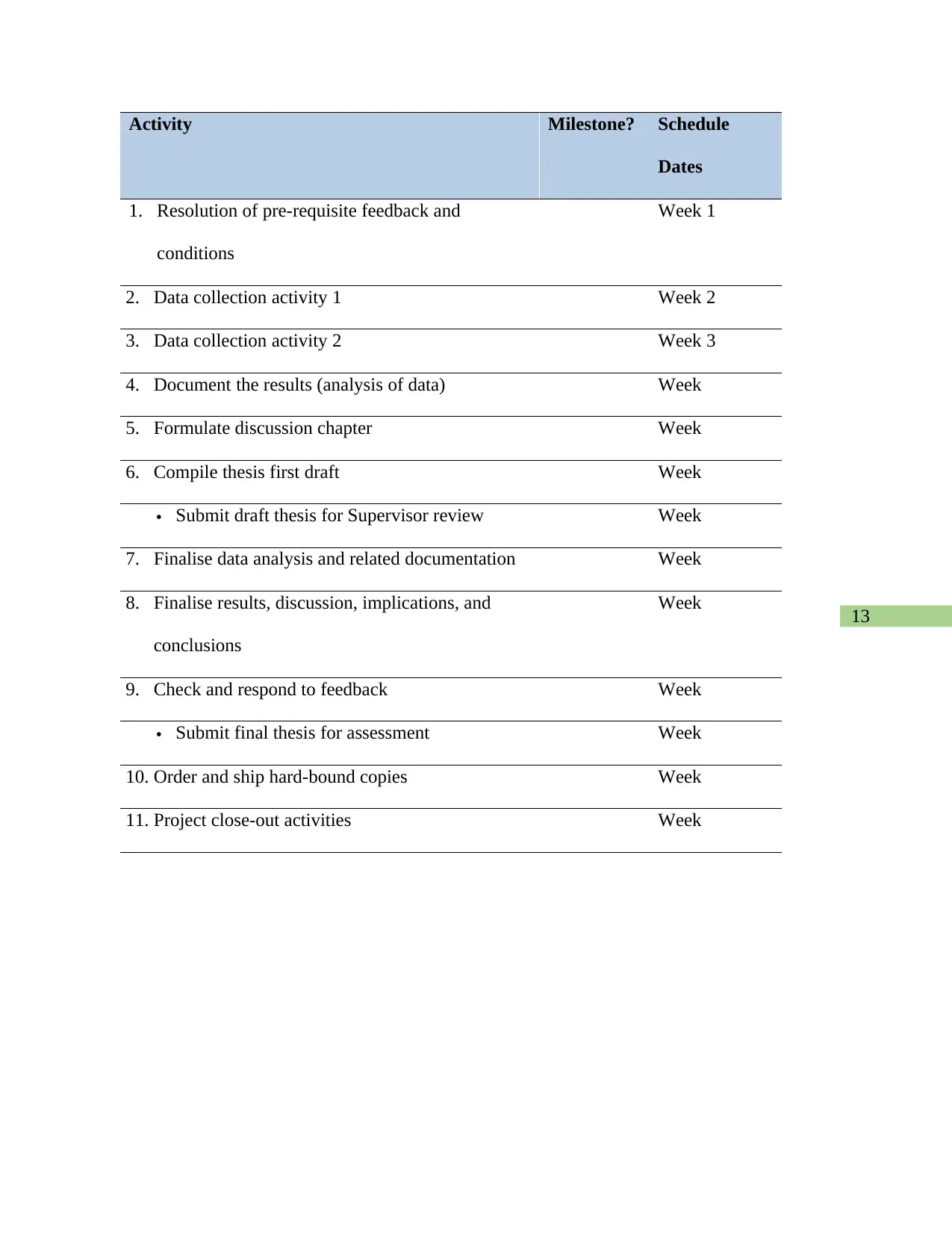
13
Activity Milestone? Schedule
Dates
1. Resolution of pre-requisite feedback and
conditions
Week 1
2. Data collection activity 1 Week 2
3. Data collection activity 2 Week 3
4. Document the results (analysis of data) Week
5. Formulate discussion chapter Week
6. Compile thesis first draft Week
Submit draft thesis for Supervisor review Week
7. Finalise data analysis and related documentation Week
8. Finalise results, discussion, implications, and
conclusions
Week
9. Check and respond to feedback Week
Submit final thesis for assessment Week
10. Order and ship hard-bound copies Week
11. Project close-out activities Week
Activity Milestone? Schedule
Dates
1. Resolution of pre-requisite feedback and
conditions
Week 1
2. Data collection activity 1 Week 2
3. Data collection activity 2 Week 3
4. Document the results (analysis of data) Week
5. Formulate discussion chapter Week
6. Compile thesis first draft Week
Submit draft thesis for Supervisor review Week
7. Finalise data analysis and related documentation Week
8. Finalise results, discussion, implications, and
conclusions
Week
9. Check and respond to feedback Week
Submit final thesis for assessment Week
10. Order and ship hard-bound copies Week
11. Project close-out activities Week
1 out of 14
Related Documents
Your All-in-One AI-Powered Toolkit for Academic Success.
+13062052269
info@desklib.com
Available 24*7 on WhatsApp / Email
![[object Object]](/_next/static/media/star-bottom.7253800d.svg)
Unlock your academic potential
© 2024 | Zucol Services PVT LTD | All rights reserved.





